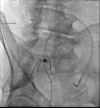Endovascular treatment of a sacral dural arteriovenous fistula
- PMID: 33547130
- PMCID: PMC7871243
- DOI: 10.1136/bcr-2020-239256
Endovascular treatment of a sacral dural arteriovenous fistula
Abstract
Spinal dural arteriovenous fistula (SDAVF) is a rare pathological communication between arterial and venous vessels within the spinal dural sheath. Clinical presentation includes progressive spinal cord symptoms including gait difficulty, sensory disturbances, changes in bowel or bladder function, and sexual dysfunction. These fistulas are most often present in the thoracolumbar region. Diagnoses of SDVAFs are commonly missed, possibly due to the low index of suspicion, non-specific symptoms and challenging imaging. In this case report, we describe a rare presentation of a sacral SDAVF which was detected by collective efforts between endovascular neurosurgery and interventional radiology. We outline the diagnostic and imaging challenges we faced to discover the fistula. In particular, mechanical pump injection instead of hand injection during angiography was required to reveal the fistula. Following identification, the fistula was successfully treated endovascularly by using onyx (ethylene vinyl alcohol glue), a less invasive alternative to surgical intervention.
Keywords: interventional radiology; neurosurgery.
© BMJ Publishing Group Limited 2021. No commercial re-use. See rights and permissions. Published by BMJ.
Conflict of interest statement
Competing interests: None declared.
Figures





References
-
- Thron A Spinale durale arteriovenöse Fisteln [Spinal dural arteriovenous fistulas]. Radiologe 2001;41:955–60. - PubMed
Publication types
MeSH terms
LinkOut - more resources
Full Text Sources
Other Literature Sources
